

|
|
Select photographs of my many visits to The Missions of the United States South and Southwest built by Spain and Mexico between 1565 and 1823. All photographs taken by Kenneth A. Larson. All rights reserved. © 2008 - 2013. |
| Explanation. |
|
South to North
| ||
Founded (Disputed, posibly 1810, 1819, 1830)
|
Personal ObservationsI learned of this estancia in early 2004 and we visited on a Friday in early November. For the hour and a half that we visited the site, my wife and I were alone. We returned a week later and saw one other visitor. On a third visit, the wedding planner was there with a young couple. This is as far inland as any mission I've |
 Mission Art & Photo-Art |
| visited and only the second time I photographed a mission with a snow capped mountain in the background. While not a full mission or even an asistencia, this estancia was still an important part of the mission system bringing Christianity to the people and providing agricultural development to the area. |
|
Estancia San Bernardino was an outlying rancho to Mission San Gabriel Arcánge. There is a debate as to whether the San Gabriel Mission outpost in San Bernardino was an estancia or an asistencia. One theory is that it became referred to as an asistencia in the 1930s rather than as an estancia in order to make it sound more important and thus, receive more restoration funding. It was probably an estancia on its way to becoming an asistencia when the mission era ended with Mexican independance and secularization in 1834. Had the second, inland, chain of missions been established, it would probably have been a link in that chain. An asistencia is defined as "a mission on a small scale with all the requisites for a mission, and with Divine service held regularly on days of obligation, except that it lacked a resident priest." Since the Plaza Church at Pueblo Los Angeles fitted that definition, the two priests assigned to Mission San Gabriel would have been occupied with administering the main Mission and its western asistencia. They lacked the time to administer similarly to an eastern asistencia. Thus, San Bernardino was never upgraded to an Asistencia. In the 1920s and 1930, the adobe ruins were restored in the appearance of an asistencia. Asistencia San Antonio de Pala was a guide for the restoration. The original rancho layout was considerably altered. I have found three dates given as the date of establishing Mission San Gabriel's Estancia San Bernardino, 1810, 1819, and 1830. Spanish exploration of the area began about 1772. San Gabriel Mission wanted a ranch or station in the San Bernardino Valley and there were Indians who could be converted to the Catholic religion. There was good farmland with creeks that could be diverted for irrigation and much level grassland that could feed cattle and sheep. The mission system became active in the Loma Linda/Redlands area in 1810 when Father Francisco Dumetz entered the region to establish the Rancho San Bernardino as an outpost of the Mission San Gabriel. Some histroical researchers believe that the location of the temporary chapel for the Rancho San Bernardino was in the immediate vincinity of the Guachama Rancheria where the present monument is located on the north side of Mission Road. A chapel (San Bernardino de Siena) may have been established in the San Bernardino valley as early as 1810 at a location some distance from the current structure. The entire area was disturbed by the 1812 earthquake stopping development. It took nine years to establish the mission station. A little chapel was built, and a long storage building that could be a home or fortress for missionaries. The first estancia was just a storage shed, with room to sleep inside. 1819 saw further development of cattle ranching in the area with quarters for a visiting missionary being available in 1820. 1819 seems to be the year generally accepted for the establishment of the Estancia. This original complex consisted of a single rectilinear chapel for serving mass protected by a low wall. An adobe granary was constructed on the north side of Mission Road sometime after 1820. The mission provided agricultural instruction to the local Indians while bringing them under the influence of the Catholic Church. Legendary trapper, Jedediah Smith visited the mission outpost in 1826 and 1827 when he stopped at the granary to replenish his supplies. It is believed that in 1820 Native Americans began to dig a zanja (irrigation ditch) to serve the area. Planned by Pedro Alvarez, the zonja, irrigation ditch, still flows through Sylvan Park near the University of Redlands. At the same time, Carlos Garcia, the Spanish majordomo (overseer) of the Rancho, directed construction of an enramada (bower or arbor) for worship, an adobe administration building with storerooms, and a personal residence. The first site was established very low in the area that had been regularly flooded by San Timoteo Creek. Majordomo Juan Alvarado (1826 - 1834) relocated the Estancia to its present site on the top of a nearby hill, farther east along what is now Barton Road. Construction of the permanent 14 room complex of adobe and timber building beginning in 1830. By 1834 the facility was abandoned by the Mission, and the Mexican Decree of Secularization ended mission control in California. The Estancia was looted by attacking Indians in 1834. Following secularization in 1834, the Estancia quickly passed into private hands. José de Carmen Lugo purchased the property in 1842. Brothers Jose del Carmen Lugo, Jose Maria Lugo and Vincente Lugo, along with their cousin Diego Sepulveda, were granted title to the San Bernardino Rancho by the Mexican Governor of California in 1843. Included in the property's inventory were the abandoned Estancia, a grist mill, a tile kiln, and a lime kiln. Jose del Carmen Lugo repaired the rancho structures and resided at the Estancia until 1851. Mormons purchased the Rancho San Bernardino from the Lugos in 1851 or 1852 and established the city and, later, the county of San Bernardino. Bishop Nathan C. Tenney was assigned to oversee agricultural operations and moved into the Estancia with his wife. One room of the complex was used as a school with Mrs. Tenney as teacher. The Estancia also served as a polling place. The area became known as the Mission District, or Old San Bernardino. In 1854, Lewis and Henry Cram established a furniture factory near the Estancia using water from the zanja to power their machinery for manufacturing furniture. The venture lasted for two years. In about 1857 or 1859, Dr. Benjamin Barton purchased the property from the Mormons. It is believed that he resided and practiced medicine in the adobe buildings until the completion of his own home, still standing adjacent to the Estancia, in 1867. Materials from the Estancia were removed for use elsewhere, and the adobe buildings gradually deteriorated. By 1925 the Estancia was only a ruin. The County of San Bernardino, assisted by the San Bernardino County Historical Society, acquired it from the Barton family. The remaining historic materials were removed, and construction of a new six room structure began in 1926 under the direction of Horace P. Hinckley. Construction was completed in 1937 as a combined state (State Emergency Relief Administration, or SERA) and federal (Works Progress Administration, or WPA) relief project. What is refered to as the Asistencia began with this restoration in 1925. Restoration and reconstruction took artistic liberties in the design of the new Estancia. The bell tower was patterned after the Pala Asistencia. Modifications were made to the floor plan to provide exhibit space and a residence for a site manager. This facility opened to the public in 1937 as the "Asistencia." In 1960, it was dedicated as California State Historical Landmark #42 as an outstanding example of handcrafted structures of the WPA era. Since that time, the site has been under the administration of the San Bernardino County Museums. The Asistencia now includes a museum, chaple, historic rooms, and gardens. Open Tuesday through Saturday 10 a.m. to 3 p.m. Sunday 1:00 p.m. until 4:00 p.m. Closed New Year's Day, Thanksgiving Day, and Christmas Day. Group tours by appointment. Admission is by donation. The site is available for weddings and events. Address and DirectionsAsistencia Mission de San Gabriel 26930 Barton Road, (E of Nevada Street) Redlands, California. (909) 793-5402 Exit the I-10 Freeway at Alabama and turn south. Follow Alabama until it ends at Barton Road and turn right. The site is about a quarter mile on the right. or Exit the 30 south at San Bernardino Avenue and turn right. Turn left at Alabama. Follow Alabama until it ends at Barton Road and turn right. The site is about a quarter mile on the right. |
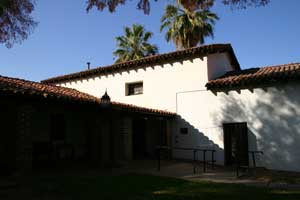 Church exterior. Photo date: 11-13-04. |
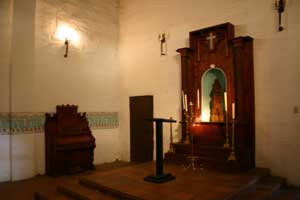 Church inerior. Photo date: 11-13-04. |
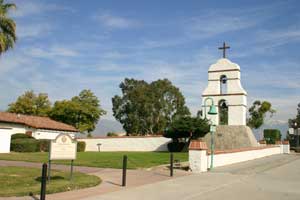 Bell tower and forecourt, sign and El Camino Bell. Photo date: 11-5-04. |
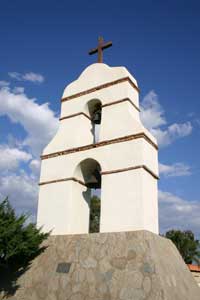 Bell tower. Photo date: 11-13-04. |
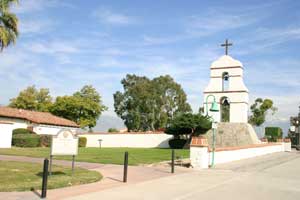 Bell tower and forecourt, sign and El Camino Bell. Photo date: 11-5-04. |
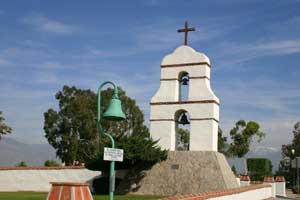 Bell tower and El Camino Bell. Photo date: 11-5-04. |
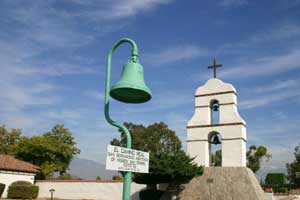 Bell tower and El Camino Bell. Photo date: 11-5-04. |
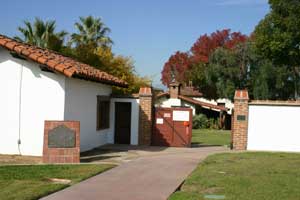 Entrance to Estancia. Photo date: 11-5-04. |
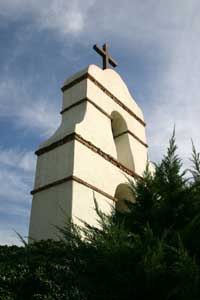 Bell tower inspired by Mission Palla. Photo date: 11-5-04. |
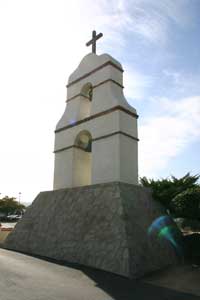 Bell tower. Photo date: 11-5-04. |
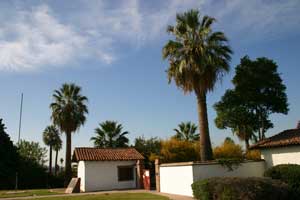 Forecourt from bell tower. Photo date: 11-5-04. |
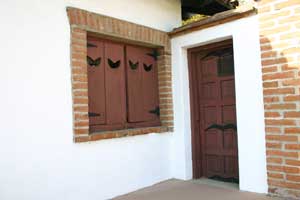 Window to wedding planning office. Photo date: 11-5-04. |
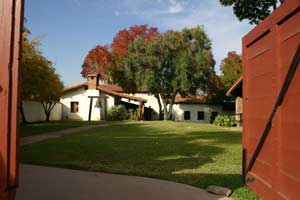 Through the gate. Photo date: 11-5-04. |
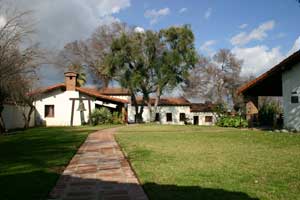 Courtyard from entry. Photo date: 1-29-05. |
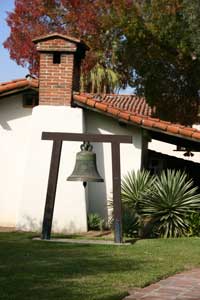 Bell. Photo date: 11-5-04. |
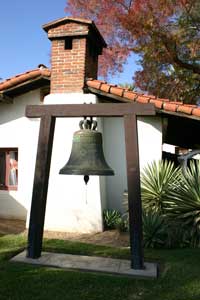 Bell. Photo date: 11-13-04. |
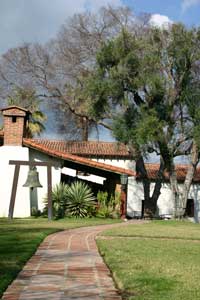 Bell with Chapel beyond. Photo date: 1-29-05. |
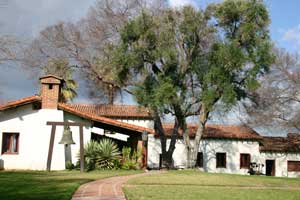 Bell and courtyard. Photo date: 1-29-05. |
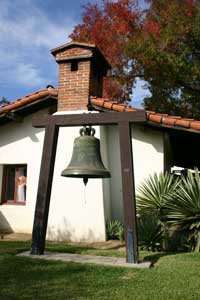 Bell. Photo date: 2-16-04. |
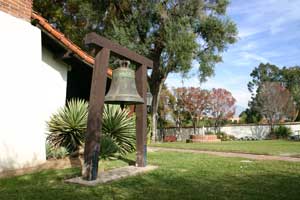 Bell. Photo date: 2-16-04. |
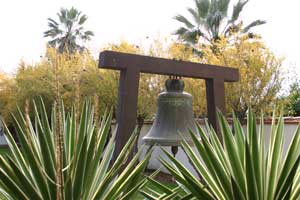 Bell. Photo date: 11-5-04. |
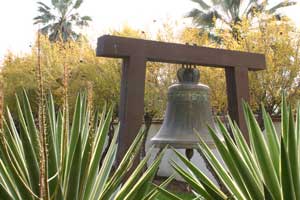 Bell. Photo date: 11-5-04. |
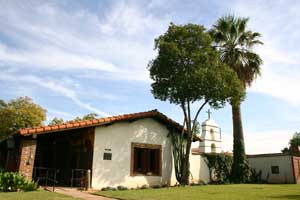 Museum and bell tower. Photo date: 11-5-04. |
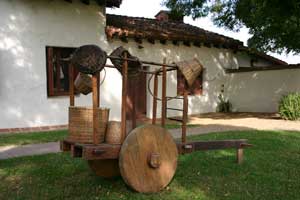 Carretta. Photo date: 11-5-04. |
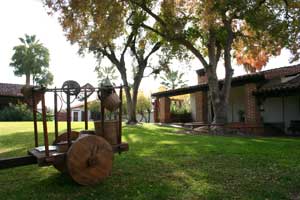 Courtyard and caretta. Photo date: 11-5-04. |
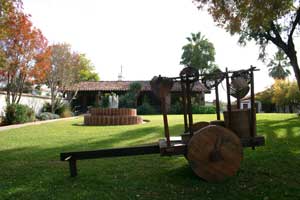 Courtyard and caretta. Photo date: 11-5-04. |
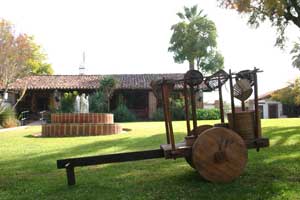 Courtyard and Caretta. Photo date: 11-5-04. |
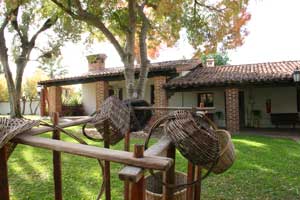 Courtyard and Caretta. Photo date: 11-5-04. |
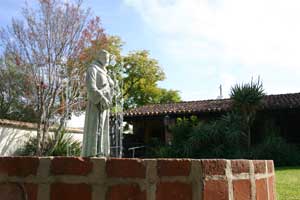 Fountain and ststue. Photo date: 11-5-04. |
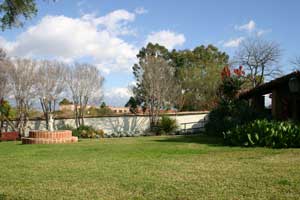 Courtyard and fountain with statue. Photo date: 1-29-05. |
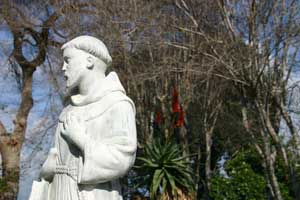 Statue. Photo date: 1-29-05. |
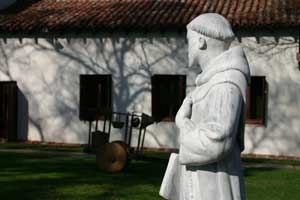 Statue. Photo date: 1-29-05. |
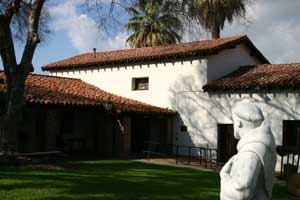
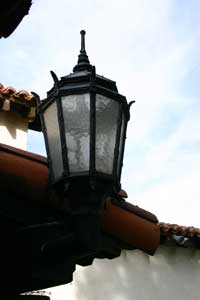 Light fixture. Photo date: 11-5-04. |
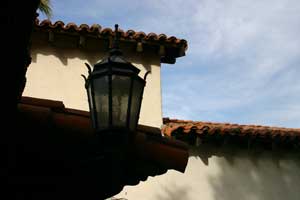 Light fixture. Photo date: 11-5-04. |
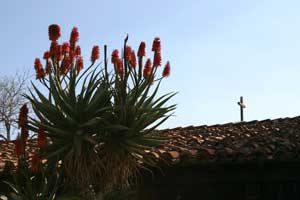 Flowers and cross. Photo date: 1-29-05. |
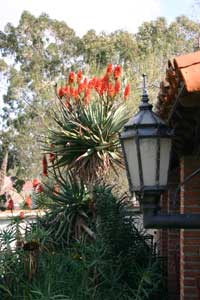 Flowers and lamp. Photo date: 1-29-05. |
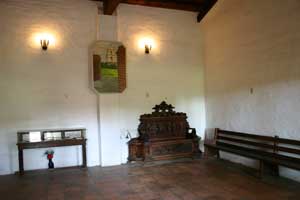 Interior of exhibit room. Photo date: 11-5-04. |
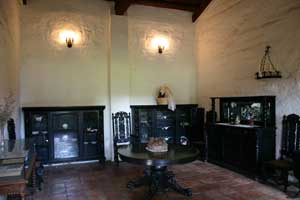 Interior of exhibit room. Photo date: 11-5-04. |
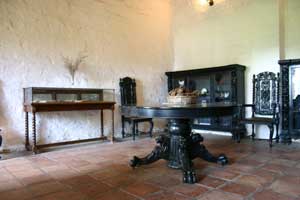 Interior of exhibit room. Photo date: 11-5-04. |
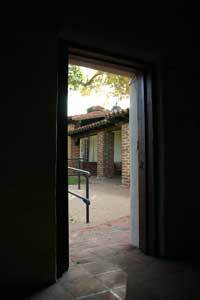 Looking out the door from an exhibit room. Photo date: 11-5-04. |
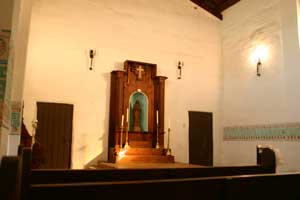 Interior of Chapel. Photo date: 11-5-04. |
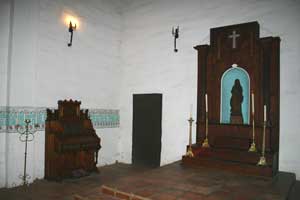 Interior of Chapel. Photo date: 11-5-04. |
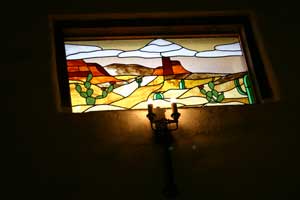 Stained glass in chapel. Photo date: 11-5-04. |
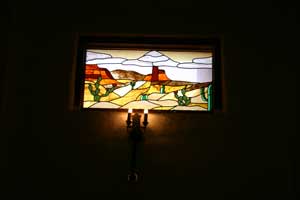 Stained glass in chapel. Photo date: 11-13-04. |
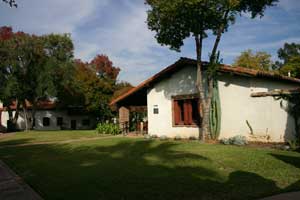 This building now houses the museum. Photo date: 11-5-04. |
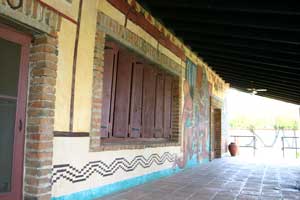 Exterior of museum. Photo date: 11-5-04. |
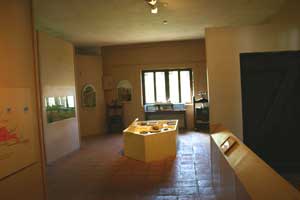 Museum interior. Photo date: 11-5-04. |
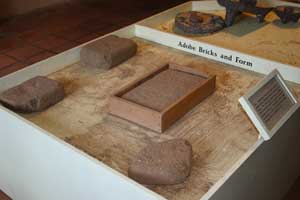 Making adobe bricks. Photo date: 11-5-04. |
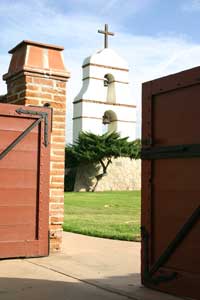 Bell tower through the gate. Photo date: 11-5-04. |
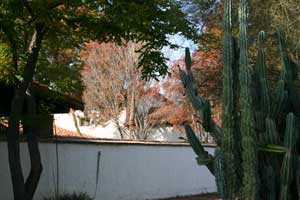 From outside the east wall. Photo date: 11-5-04. |
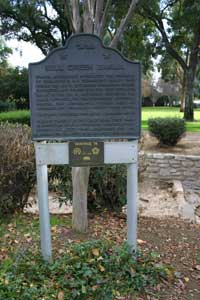 Zanja in Sylvan Park. Photo date: 11-13-04. |
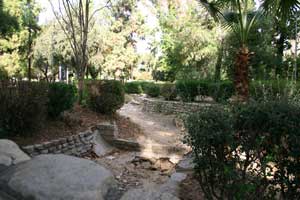 Zanja in Sylvan Park. Photo date: 11-13-04. |
|
South to North
| ||

|

|

|
| Note:This is not the official site for any of the places shown in US Mission Trail. US Mission Trail is not responsible for accuracy of the information. Hours of operations, prices, and exhibits are subject to change without notice. |
|
Support this Web Site I hope that you find this web site helpful. It started because of my love for the California Missions and interest in History and a desire to share my photographs and tales of my adventures. I don't allow paid advertising. This web site is for your benefit and enjoyment and I make no profit on it. For twenty years it has been supported primarily from my regular paycheck as a Set Designer. A non-tax deductable donation helps cover the cost of operating this web site and may be made to Kesign Design Consulting through PayPal. | ||
|
If you are in the need of a designer, please see my Set Designer portfolio site Set Design Portfolio. |
| Or donations can be mailed to the address on the contact page. |
|
Links
Home |
Contact |
Sales |
Ken Larson |
K L Images |
Places Earth
|

|
This site maintained by Kenneth A. Larson. Copyright © 2004 - 2023, Kenneth A. Larson. All Rights Reserved. Website content including photographic and graphic images may not be redistributed for use on another website. |

|

|

|